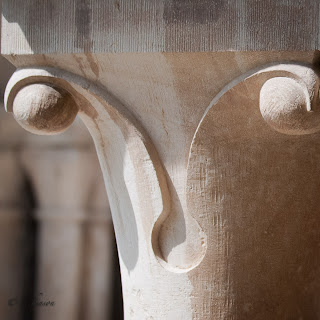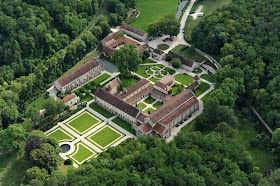A couple of weeks ago I posted Part 1 of Abbey Road where I described the beginnings of Fontenay, the gorgeous Cistercian abbey located deep in rural Burgundy. For those who missed that post, I talked about how moved I was by the utter simplicity of the architecture and the beautiful contemporary landscaping that provides a perfect setting for the ancient buildings. Today I'd like to talk about the architecture in a little more detail.
Despite having been used as a paper mill for over 100 years,
nearly all of Fontenay’s original buildings remain intact; only the refectory
has been lost to time. The chapel and cloister, chapterhouse, scriptorum, dormitory,
forge, infirmary, dovecote, visitor's chapel and abbot’s house have all been restored and most of the buildings are open to the public.
The Cistercians who founded the abbey advocated a simple life of work and prayer, and eschewed everything that was ostentatious. Saint Bernard criticized the abundant use of decoration, sculpture and gilding in religious buildings, particularly in monasteries, and wrote "The very sight of ... sumptuous and exquisite baubles is sufficient to inspire men to make offerings, though not to say their prayers."
The abbey church at Fontenay perfectly reflects his belief in austerity.
 |
| The west facade of the abbey church. (Click on any photo to enlarge.) |
 |
| The unassuming bell gable. The monks' dormitory is located on the second floor. |
 |
| On the right is the central section of the facade with smooth ashlar blocks. Smaller, rough-cut stones were used on the sides. |
The façade is nearly flat, relieved only by a slightly projecting belt course and two vertical buttresses that express the tripartite division of the interior (a central nave with side aisles). The piers and the belt course create a perfect square in the center of the facade, which is marked by a round-arched door flanked by slender columns. Located high in the wall are two tiers of round-arched windows, arranged in typically Cistercian fashion. All of these architectural elements work together to concentrate the viewer's attention on the center of the building and to pull the visitor into the church.
Once inside the central nave leads the viewer's eye to the chancel at the far end. A flying screen with five windows separates the chancel from the nave, and additional windows in the flat east wall shed light on the altar area. The long barrel vault that covers the nave is separated into eight bays and supported by arches that are slightly pointed instead or semi-circular. Because of this detail the architecture of Fontenay has been viewed as a precursor to the Gothic style with its pointed arches. Engaged columns cluster around the structural piers, and the capitals are decorated with only the subtlest of carvings.
Equally interesting, but in an entirely different way, is
the abbey forge. Because the Cistercians lived in isolated locations they were required to be entirely self-sufficient. As a result, the monks and lay brothers were excellent farmers and the order made great strides and improvements in the areas of farming and animal husbandry.
They were also excellent metal workers and Fontenay retains one of their earliest forges. The two-story masonry structure, which dates to the late 12th century, is one of the
oldest industrial buildings in France. The
center room contains an enormous fireplace for heating the metal. In the adjacent
room a long wooden shaft is connected to a large mill wheel on the side of the building. The monks diverted the local stream into a mill race, the water of which turns the
mill wheel. This movement causes the shaft to turn. Attached to the shaft is a lever arm that raised a heavy, iron-clad wooden hammer, which fell by gravity and pounded the wrought iron. This device, which is claimed to be the first
hydraulic hammer, allowed the monks to work the iron ore that they mined
nearby.
Because of their development of the hydraulic hammer and numerous other improvements that they made in the field of metallurgy, the Cistercians were directly responsible for much of the technological progress of the Middle Ages. This is probably not exactly what the monks had intended when they withdrew to this isolated site and devoted their lives to work and prayer.
For those of you who are interested in visiting this remarkable site, here's a map to help you find Fontenay Abbey.
 |
| The forge. The mill wheel is located out of sight on the far side of the building. |
 |
| This mill wheel... |
 |
| turned this wooden shaft... |
 |
| which raised this lever arm to work the wrought iron. |
For those of you who are interested in visiting this remarkable site, here's a map to help you find Fontenay Abbey.








No comments:
Post a Comment